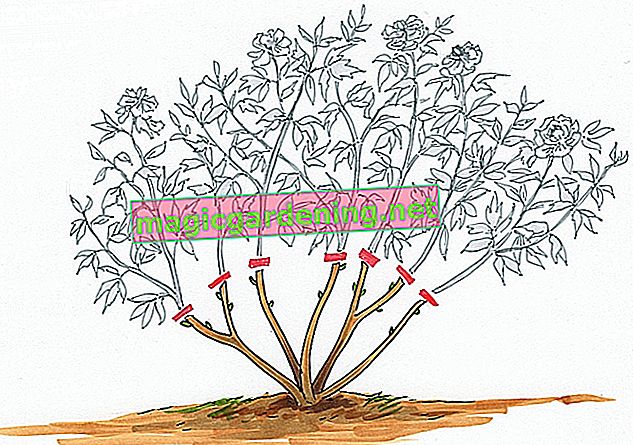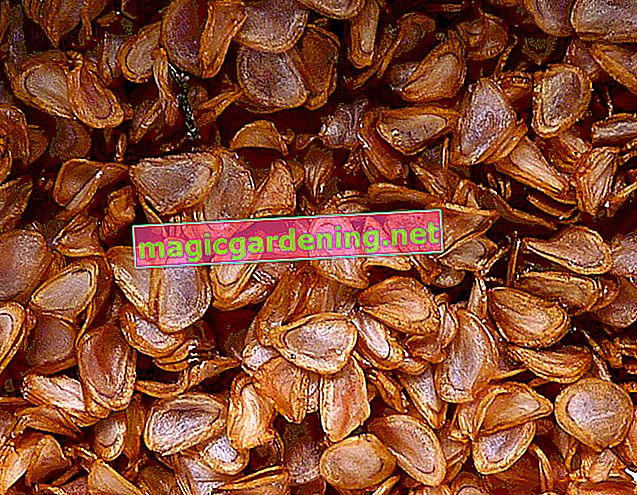
Skillfully cut the harlequin under the bushes - all types of cut and dates
The multi-faceted genus of willows (Salix) gives home gardeners the variegated variety 'Hakuro Nishiki' one of the most colorful ornamental trees for imaginative garden design. The piece of jewelery is known under the name 'Harlequin Willow' (Salix integra) and found its way from East Asia to our gardens in 1979. The appearance is characterized by white-pink-green leaves on yellowish to reddish branches. After the inconspicuous catkins bloom from March to April, the pretty leaves sprout from the beginning of May.
also read
- How to cut your willow correctly - instructions in the tutorial
- Cut harlequin willow as a ball
- How To Cut Oleander Properly - Home Gardener Cutting Tutorial
On the young twigs , the splendor of the leaves unfolds in their most beautiful form. Legendary is a pink-cream-colored leaf shoot, which from a distance looks as if the harlequin willow has blossomed. Consistent cutting consequently has top priority in the uncomplicated maintenance program. A regular exchange of perennial for this year's shoots guarantees a never-ending play of summer colors in the leaves. The following table summarizes for you which types of pruning are recommended for the harlequin willow as tall trunks and ornamental shrubs:
| Cut type | Goal / occasion | best date |
|---|---|---|
| Topiary high trunk | Cut the crown to size, remove dead wood | Late winter (January to early March) |
| Care cut high trunk | The shape of the crown is compact and has variegated leaves | end of June |
| Plant cut shrub | dense branching at the base | after planting |
| Conservation cut shrub | spherical, compact shrub shape, thinning out dead wood, continuous rejuvenation | from the 3rd year in late winter (January to early March) |
| Maintenance pruning shrub | Opaque growth, well-groomed appearance | from the 3rd year at the end of June |
| Rejuvenating cut shrub | Revitalize the aged harlequin pasture | November to the end of February |
When choosing a date for a cut on your harlequin pasture, the current weather conditions are decisive. The pruning care in February works without any problems on a frost-free, overcast day . In summer, give preference to a warm but not scorching day. Full sun and drought are the most important exclusion criteria for cutting times around St. John's Day.
Topiary keeps the tall stem crown tight and colorful
On this year's shoots, a tall stem crown bears the most colorful leaves. An annual pruning of the previous year's crown branches clears the way for a fresh shoot. How to cut properly:
- The best time is in February, before budding begins
- Cut back all crown shoots except for short cones
- Apply the scissors 3 to 5 millimeters away from a bud
With the radical pruning of the crown branches, you bring about a strong new shoot of young shoots. A supplementary supply of nutrients is beneficial for growth. After the topiary, fertilize with compost and horn shavings. (€ 6.39 at Amazon *) Harlequin willow in the bucket gratefully accepts a liquid fertilizer for green plants.

Digression
Cut harlequin willow with bypass or anvil scissors?
Willow wood is very soft and therefore easy to cut. This characteristic makes the pruning of your harlequin willow easy and uncomplicated. Use one-handed secateurs when pruning a crown or shrub. The bypass scissors with two sharp blades are recommended for a smooth cut. With anvil scissors there is a risk that the soft wood will be pinched between the sharp blade and the blunt anvil and frayed.The tall trunk crown benefits from the summery, nourishing cut
Due to the strong shape cut in February, strong growth sets in, which makes another cut in summer useful. So that your harlequin willow flourishes as a tall trunk with a shapely and densely compact crown, grab scissors again around St. John's Day at the end of June. At this point the plants take a break from growing. A second, weaker shoot follows with fresh, colorful ornamental leaves. How to properly prune your harlequin sapling in summer:
- Cut back the crown branches by a third or half
- Alternatively, simply shorten branches protruding from the crown shape
- Remove shoots sprouting from the trunk or the root disc
High trunks of a harlequin willow are grafted onto the trunk and rhizome of a robust wild species. As a result, wild shoots sprout from the trunk or the root disc. In every game shoot rests a vehement growth force, which is superior to the branches of the noble crown. So that the wild shoots do not take over the command as they grow and overgrow the precious part, they should be removed promptly. Act here according to the rule of thumb: All shoots below the grafting point at the base of the crown must be removed as quickly as possible.
background
Broad-spherical crown shape has many advantages
As a tall trunk, the harlequin willow comes with a natural spherical crown. A double cut contributes significantly to the fact that your tree retains the advantageous crown shape. Round crowns guarantee an unhindered supply of light, so that photosynthesis can be carried out on all branches and twigs. This results in densely leafy growth from spring to autumn from the tip of the crown to the base of the trunk. Without a cut, the ornamental willow loses its harmonious spherical shape over the years and turns into an expansive, flat-oval growth up to 200 centimeters wide, which is more reminiscent of a failed pancake.Cut harlequin willow as a shrub after planting - this is how it works
Planted out as a shrub in the bed, the harlequin willow is a real splendor. By nature, ornamental willows have a hemispherical habit with a height of up to 300 centimeters. As a solitary, decorative group or free-growing hedge, 'Hakuro Nishiki' attracts everyone's attention in small and large gardens. So that harlequin willow bushes branch densely from the roots to the tips of the bushes, a plant cut sets the course. That is how it goes:
- The best time is immediately after planting
- Alternatively, make up for the pruning in February of the following year
- Cut back bare-root young shrubs by half
- Shorten young plants in pots or containers by a third
As the illustration below illustrates, the expert pruning of the plant requires a radical approach. Don't let that confuse you. They cause a sap build-up in the lower buds, which ensures strong branching at the plant base with a long-term effect.

Digression
High sap pressure gets the budding going
The decisive factor for the intensity of budding and growth is the sap pressure. Like most plant species, willows also pump their juices vehemently and in a targeted manner to the top buds of their shoots. The reason for the floral strategy is the fastest possible growth in sunlight so as not to be overshadowed by neighboring plants. The further down the position of a bud, the lower the sap pressure and growth. If you cut back the shoots as part of the planting, buds that were previously subordinate to take the lead and are given a correspondingly strong flow of sap. Since fewer buds need to be served at the same time, the sap pressure increases on each remaining bud, whereupon a strong shoot begins.For a shrub in top form - shape and maintenance pruning
After pruning, leave a harlequin willow bush to grow for two to three years. Your ornamental willow completes the development phase for hemispherical shrub beauty without horticultural intervention. Starting with the third year of standing, a shape and maintenance cut guarantees youthful vitality and a colorful foliage garment. How to do it right:
- The best time is in February on a frost-free day
- Examine the bush in advance for animal winter guests in order to postpone the appointment if necessary
- Thinning out dead branches at the base
- Do the same with crosswise or inward-growing shoots
Once dead wood and unsuitable branches have been removed, dedicate yourself to the topiary. Do not cut back all the shoots uniformly. So that the beautiful, hemispherical shape is retained, shorten the branches that are outside. Overall, the shoots should be cut back by at least a third in order to encourage the budding of this year's young branches. A cut of up to two thirds is easily possible if you do not want a privacy screen function in the first few months of the gardening year. After the cut, fertilize with compost and horn shavings and pour plenty of water.

Tips
Ornamental willow 'Hakuro Nishiki' is native to East Asia. Unlike native willow species, your harlequin willow cannot rely on a home advantage for disease resistance. Therefore, when cutting, be careful to work with clean, disinfected blades . Pathogenic germs use unclean cutting tools as an ideal means of transport to cut wounds in woody plants.
Care cut prevents the leaves from turning green in summer
A strong pruning in February is followed by a correspondingly strong shoot of long, flexible branches with beautifully variegated leaves. As the summer progresses, the leaves on the harlequin willow shrub noticeably green. It is therefore an advantage if you prune again between the end of June and mid-July. How to proceed professionally:
- Examine harlequin pasture carefully for nesting birds in order to postpone the appointment if necessary
- Cut off this year's growth with freshly sharpened, disinfected scissors
- Shorten shoots outdoors more than shoots in the center of the shrub
Please do not cut ornamental willow shrubs in sweltering heat or during a summer drought. Ideally, choose a time with mild temperatures and overcast skies.
background
Note the summer grace period when cutting trees
For three good reasons, this tutorial advocates moderate summer pruning on ornamental willows as a shrub and high stem. If you cut back this year's growth on your harlequin pasture on St. John's Day, a fresh breeze will come into the color festival of the leaves. At the same time, you support the compact, dense, bushy growth of the crown and shrub with a care cut. First and foremost, you take an urgently needed consideration for the breeding season of numerous bird species. The summer grace period is manifested in the Federal Nature Conservation Act for the period from March 1st to September 30th. Moderate cuts in trees are allowed to provided no nests in the branches are located.Rejuvenate the old harlequin shrub - clear the way for fresh colors
Without an annually recurring shape and maintenance pruning, a harlequin willow shrub is only vaguely reminiscent of the premium variety 'Hakuro Nishiki'. Rather, the wood presents itself as an impenetrable network of old and young shoots with uniformly green foliage. This is no reason to throw the gun in the grain and clear the harlequin pasture. Now you benefit from the robust cut tolerance. By placing the aged shrub on the cane , you clear the way for a rebuild. This is how the plan works:
- The best time is between November and the end of February on a frost-free day
- First examine the dense shrubbery for animal winter guests
- Saw off dead wood until it is just above the ground
- Cut back the remaining shoots to 20 or 30 centimeters
Direct the growth into the natural, hemispherical shape when making the taper cut. For this purpose, shorten ground shoots inside the shrub less than shoots outside. To encourage branching from below, cut back the growth by half to two thirds at the end of June the following summer. In addition, we recommend fertilizing twice in early March and early July with compost and horn shavings or an organic fertilizer from specialist shops.

background
Putting on the stick activates dormant buds
The categorization of harlequin willow as a cut-compatible wood is primarily based on its ability to sprout fresh from old wood. The floral masterpiece succeeds because the plant creates dormant buds as it grows. These serve as the last line-up if other parts of the plant fail, such as branches, twigs or the trunk. The technical jargon calls the secret vegetation points sleeping eyes, because they are located as tiny dots under the bark. By placing a harlequin willow bush (not the high trunk!) On the stick during rejuvenation, dormant buds are activated and guarantee that young shoots and leaves will sprout again.frequently asked Questions
I would like to plant a deciduous hedge with privacy protection in the front yard. Is the harlequin pasture suitable for this?
If you have a freely growing hedge in mind as an enclosure and privacy screen, the harlequin willow is ideal. With an annual maintenance pruning in February and topiary pruning at the end of June, ornamental willows thrive compact and opaque during the summer. For a strictly formal hedge, you should use other deciduous trees, such as privet or hornbeam.
Which underplanting is suitable for the harlequin willow as tall trunks?
As a tall trunk, the harlequin willow is refined to a robust type of willow, like wicker. Since all willows thrive as shallow roots, the appropriate underplanting should be low-competitive. Elven flowers (Epimedium), lady's mantle (Alchemilla), cranesbill (Geranium) and foam blossom (Tiarella) are recommended.
Lady's mantle, foam blossom or cranesbill
We planted our harlequin willow 2 years ago as a high trunk. When should the first cut back be made? What should you watch out for?
On a harlequin pasture, the crown should be cut “hedgehog short” every spring. The most colorful leaves are formed on young shoots. In the course of the summer you can cut the spherical crown into shape or let it grow uncut as you wish. Please never cut the ornamental willow “Harlequin” in frost, heat or drought.
My ornamental willow 'Harlequin' is in the sunny front garden and suffers from numerous brown leaves. What can I do against it?
As an immediate measure, we recommend shading the crown, for example with a parasol. For a sufficient water supply, please check daily in the early morning with a finger test whether the soil is dry and should be watered. A slight cut back close to St. John's Day (June 24th) also helps to solve the problem. Then apply compost with horn shavings to reach under the floral arms of the suffering wood.
On my 3 meter high 'Hakuro Nishiki' the leaves turn brown and black. At the same time, hordes of ants are on the move on the tree. What is the plant missing?
When ants frolic in an ornamental pasture, lice are not far. Ant workers piggyback aphids, transport them to the leaves, and milk the honeydew that the pests produce. Brown discolorations of the leaves indicate that lice are removing the sap from the plant. Sooty mildew is already spreading on black willow leaves, a common consequence of aphid infestation. Fight the aphids with a spray solution of 1 liter of water, 2 tablespoons of pure curd soap and a splash of alcohol. The ants then stay away from the inhospitable place for lice by themselves. Finally, cut all affected shoots back into the healthy wood.
Shoots sprout from the trunk of the grafted harlequin willow trunk. I will remove these wild shoots as soon as possible. What type of willow is the rootstock? Can I use the shoots as cuttings in the garden?
High trunks of harlequin willows are usually grafted on wicker willow (Salix viminalis). The willow species is known for the strong growth of its branches of 100 to 200 centimeters per year and thrives in any normal garden soil. You can plant the trunk shoots as cuttings in the sunny to partially shaded bed in order to grow a willow bush or small tree.
The 3 most common mistakes
Only an annual pruning makes the harlequin willow the floral light that makes gardeners' hearts beat faster. If there are no shape or maintenance cuts, the ornamental willow grows old into unsightly undergrowth or disappoints with a misshapen crown and plain green leaves. In order to protect you from mistakes in the cut, we name the three most common cutting errors by name, point out typical damage patterns and give tips for prevention:
| Cutting errors | Damage | prevention |
|---|---|---|
| Never cut back the stem crown | Spreading, misshapen crown, no variegated foliage | Cut the crown back to short cones in February |
| Harlequin bush not exposed | premature aging, dense undergrowth as old and young branches | clear in every late winter from the 3rd year |
| no cut back | no pink-green shoots, little foliage color | Cut back the tall trunk and shrub at least once a year |
Another frequent mistake with fatal consequences results from confusing harlequin willow (Salix integra 'Hakuro Nishiki') with a hanging kitten willow (Salix caprea 'Pendula'). The latter wears soft catkins from March to April as its most beautiful ornament. Therefore, the pruning of the tall stem crown and shrub is done after the flowering period. A cut in February would destroy all hopes for the silvery shimmering kittens.
YoutubeTips
Have you prescribed a change of location for your harlequin pasture within the first five years? Then the wood will forgive you the associated stress if you choose the leaf-free autumn time as the date. As shallow roots, tall stems and shrubs lose plenty of root mass when they are transplanted. Cut back an ornamental willow by at least half to restore the balance between above-ground and underground growth.








